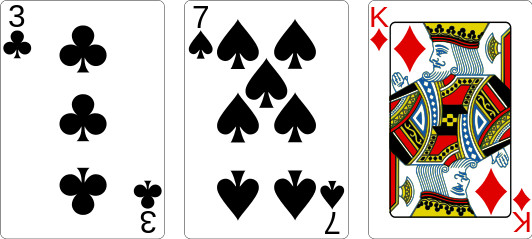
Shuffle a deck and deal three cards face down. A friend looks at the cards and turns up two that are the same color. What’s the probability that the remaining card is also of this color?
The answer is not 1/2 but 1/4. Three randomly selected cards might have any of eight equally possible arrangements of color. In only two of these (RRR and BBB) are all the colors the same. So the chance of this happening is 2/8 = 1/4.
(Martin Gardner, “Modeling Mathematics With Playing Cards,” College Mathematics Journal 31:3 [May 2000], 173-177.)
10/18/2020 UPDATE: A number of readers have pointed out that the probabilities here aren’t quite accurate. Gardner was trying to show how various mathematical problems can be illustrated using a deck of cards and contrived this example within that constraint, focusing on the “seeming paradox” of 1/4 versus 1/2. But because the cards are dealt from a finite deck without replacement, if the first card is red then the second card is more likely to be black, and so on. So the final answer here is actually slightly less than 1/4 — which, if anything, is even more surprising, I suppose! Thanks to everyone who wrote in about this.
